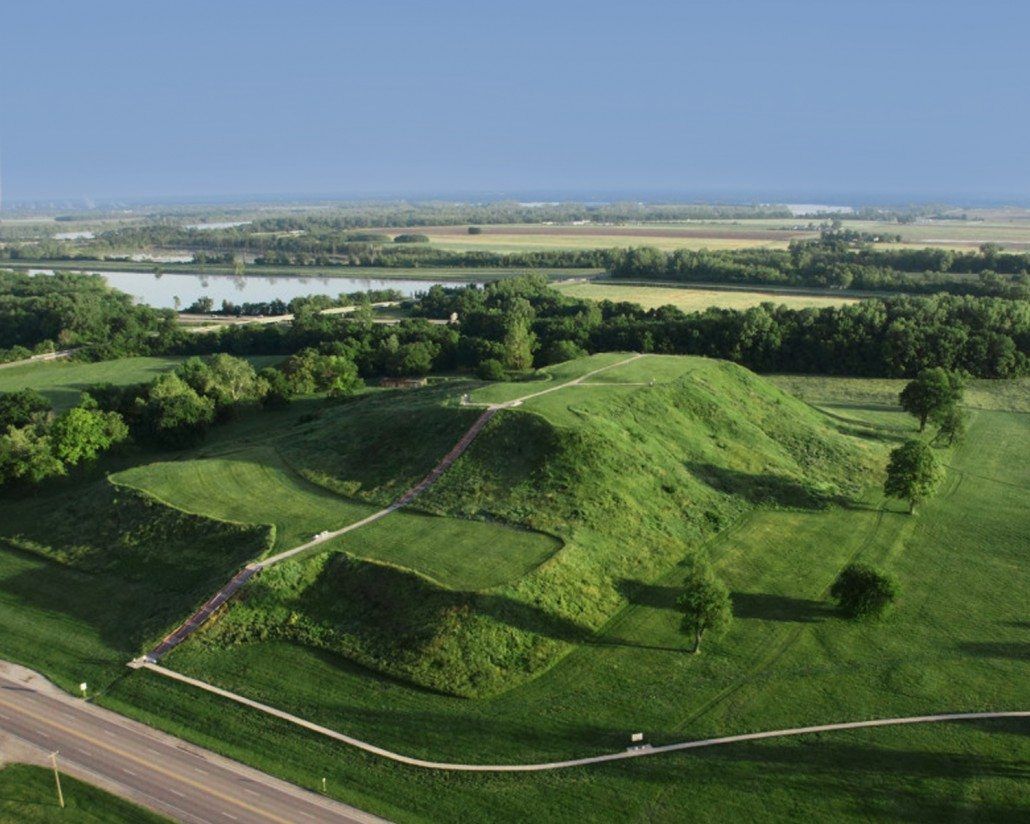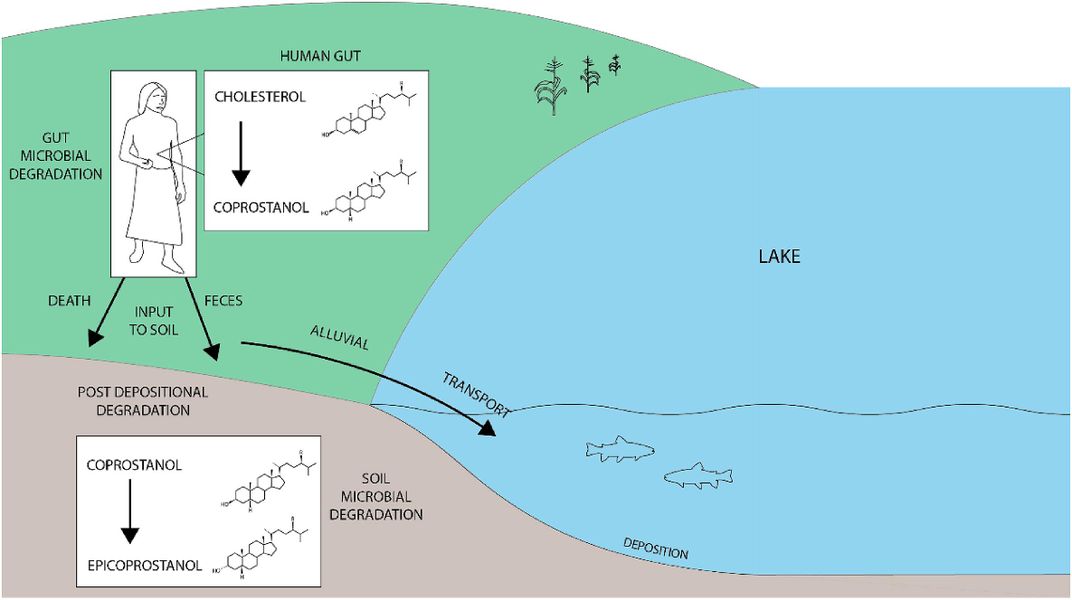How the Remnants of Human Poop Could Help Archaeologists Study Ancient Populations
Undigested molecules persist in soil for hundreds or even thousands of years, acting as biomarkers that show the ebbs and flows of bygone civilizations
:focal(519x524:520x525)/https://tf-cmsv2-smithsonianmag-media.s3.amazonaws.com/filer/b7/da/b7da6860-6f34-4785-a905-651291f76e39/cahokiamounds-dig-5-1030x824.jpg)
Rising high above the surrounding landscape, the Cahokia Mounds in Illinois stand as the largest pre-Columbian settlement built north of the Rio Grande. Archaeologists have long debated the exact number of people that called Cahokia their home, but estimates suggest as many as 20,000 may have lived among the hundreds of houses and enormous plazas (including one the size of 45 football fields) that topped the city's mounds around 1000 A.D. Then, for reasons not entirely understood, the civilization that built such massive earthen structures disappeared. By 1350 A.D., the region was mostly abandoned.
The city that vanished about 700 years ago presents a captivating question for archaeologists: What happened to the Mississippian people who built Cahokia? Key to solving that mystery is the less obvious but equally important question of how the population of the great mound city changed over time.
“Getting at population history in archaeology has always been slightly difficult and indirect,” says A.J. White, an anthropology graduate student at U.C. Berkeley. Researchers can survey the domestic architecture and estimate the number of people living in houses, or look at the density of artifacts like pottery fragments, or even count burials in cemeteries (when they exist). But these methods are proxy measurements that rely on estimation. What scientists really need is a compound left behind by humans living on the landscape, something that could reflect the size of the population as it rose and fell.
Something like a special molecule found in human poop.

Just such a biomarker is the subject of a recent paper authored by White and colleagues and published in the Journal of Archaeological Science. The researchers looked at the effectiveness of measuring coprostanol—a molecule of partially digested cholesterol produced in the human gut—as a way to measure the changing population of Cahokia. To their delight, the amount of coprostanol extracted from sediment cores taken from nearby Horseshoe Lake closely tracked with the population trends indicated by the archaeological record.
“The results from Cahokia are really promising,” says Elizabeth Arkush, an archaeologist at the University of Pittsburgh. It’s a good sign for Arkush’s own research; she’s one of the principal investigators in an ongoing project to use the same fecal markers to study population changes in Peru.
Cahokia was an ideal place to start, in part because it has been so extensively studied. Archaeologists already have an idea of how the population fluctuated over time thanks to the remnants of architecture and artifacts, even if they can’t pinpoint the precise number of people living there. In addition, the people of Cahokia didn’t have domesticated pigs or sheep, which also produce coprostanol and could skew scientists’ measurements of the human population.
White’s group took samples from the cores of lake sediment and isolated coprostanol as well as a compound that it degrades into, called epi-coprostanol. “In humans, coprostanol is a somewhat significant component of feces,” White says. “It comes to a decimal point of a percentage of the total composition of the stool.”
Considering human poop is about 75 percent water, even a fraction of a percentage makes coprostanol a pretty significant component. (It's also one of the compounds that gives feces its pungent odor.) The team then compared the two cholesterol by-products to a third molecule that also exists in human waste but degrades at a different rate. The combination of these measurements reflected the changes to Cahokia’s population over several centuries, and examining multiple molecules helped reduce uncertainties that result from the degrading compounds.
The study serves as a proof-of-concept to test the fecal method in a temperate region like Cahokia. Measuring coprotanol is a fairly new technique for estimating population sizes, and the first efforts to use human fecal biomarkers to study ancient settlements were conducted in places like Norway, where the cold temperatures help preserve the compounds. White and his colleagues were pleased to find that molecules from Cahokia, where temperatures get much higher, were well preserved enough to estimate the number of people living in the city hundreds of years ago.
“I don’t see this as something which will replace former methods of estimating population, but rather can supplement our knowledge in a new way where traditional methods can’t,” White says.
The technique still has plenty of kinks to work out. For one thing, coprostanol doesn’t degrade at a consistent rate as far as scientists can tell. For another, the amount of coprostanol an individual human produces depends on their diet—though White says the influence of a person’s diet is not entirely clear.
“If someone wanted to just eat meat for a month and then do some gross laboratory stuff, and then eat tofu for a month and do some more gross laboratory stuff, it’d be very productive,” he says. “But I don’t know if the lab manager would be very happy if I proposed it.”

Elements of the environment and human culture can also change how much feces ends up in bodies of water, where the molecules are preserved in sediments. If a community was located near the lake and surrounded by hills, that might mean more runoff into the water and higher levels of fecal biomarkers. On the other hand, if the community used human manure as fertilizer, it’s likely that fewer coprostanol molecules would show up in the lake record.
These considerations are particularly important for Arkush and her team, who have been working to achieve similar results in the Andes around the basin of Lake Titicaca, where the human presence goes back to around 5000 B.C. The population history of the region is much more complicated than that of Cahokia, accounting for numerous civilizations and cities. The city of Tiwanaku was the main power of the region in 400 A.D., followed by the arrival of the Inca around 1450 A.D. and then the Spanish conquistadors in roughly 1500 A.D.
The project in Peru began in 2015 and is still in the lab analysis phase, but the team has successfully identified coprostanol in lake cores. The work presents a way to supplement previous archaeology-based measurements, such as a long and arduous undertaking known as a full coverage survey. In these surveys, groups of people walk in straight lines with their eyes glued to the ground in search of artifacts, then record the location and density of those artifacts to build a map of ancient settlements.
“If you like walking and hiking, it’s an awesome way to spend your days,” Arkush says, but it can be extremely difficult to measure nomadic populations that lived in the region only briefly. “If it turns out that stanols do track population over time, then that opens up a lot of wonderful opportunities for understanding human population levels in areas where it’s difficult to do that archaeologically”—places like the encampments of hunter-gatherers.
Fecal biomarkers might also help archaeologists understand how intensively these groups were using domesticated animals such as llamas, as unique biomarkers in animal droppings can be identified as well. But pulling tiny molecules from all that ancient poo is a lengthy process.
“To take one sample from being fresh sediment through to being able to analyze it would take you a week,” says Josef Werne, a biogeochemist also working on the Peru project. The team has about 30 samples from each of three lakes in the region (Umayo, Arapa and Orurillo), which translates to a lot of hours putting sediments through various machines and analyzing the results.
Even after all that work, numerous variables can complicate the picture when studying fecal biomarkers. The final results in Peru will hopefully offer a new tool to study the flux of people around the region, rather than an absolute headcount of any specific settlement. But as the catalogue of fecal remnants grows, perhaps the byproducts of human waste will tell us as much about historic populations as buried houses and potsherds.
“I’m cautiously optimistic,” Werne says of their work. There’s still plenty to be done before the Peru team will be ready to publish any results, but if the findings are as promising as the Cahokia study, there could be a whole lot of ancient poo in the future of archaeology.
/https://tf-cmsv2-smithsonianmag-media.s3.amazonaws.com/accounts/headshot/lorraine.png)
/https://tf-cmsv2-smithsonianmag-media.s3.amazonaws.com/accounts/headshot/lorraine.png)